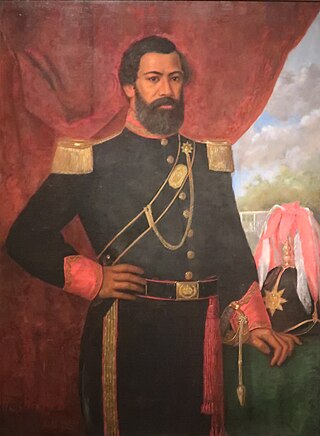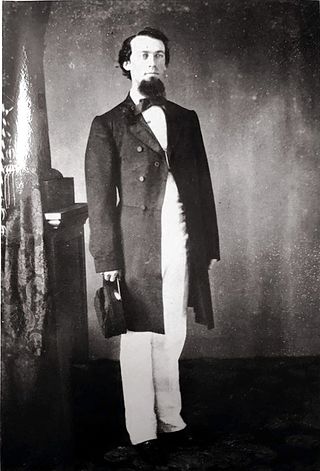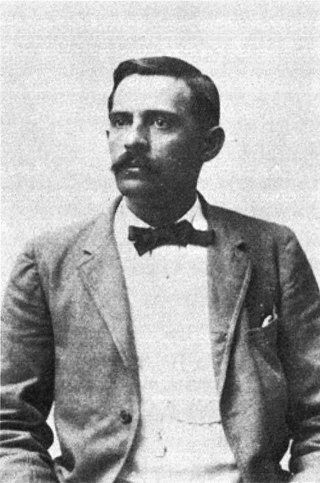Related Research Articles

Hilo is the largest settlement in Hawaii County, Hawaii, United States, which encompasses the Island of Hawaii, and is a census-designated place (CDP). The population was 44,186 according to the 2020 census. It is the fourth-largest settlement in the state of Hawaii and largest settlement in the state outside of Oahu.

Kalākaua, sometimes called The Merrie Monarch, was the last king and penultimate monarch of the Kingdom of Hawaiʻi, reigning from February 12, 1874, until his death in 1891. Succeeding Lunalilo, he was elected to the vacant throne of Hawaiʻi against Queen Emma. Kalākaua had a convivial personality and enjoyed entertaining guests with his singing and ukulele playing. At his coronation and his birthday jubilee, the hula, which had hitherto been banned in public in the kingdom, became a celebration of Hawaiian culture.

Mauna ʻAla in the Hawaiian language, is the Royal Mausoleum of Hawaii and the final resting place of Hawaii's two prominent royal families: the Kamehameha Dynasty and the Kalākaua Dynasty.
The following is an alphabetical list of articles related to the U.S. state of Hawaii:

Hawaii Tribune-Herald is a daily newspaper based in Hilo, Hawaii. It is owned and published by Oahu Publications, a subsidiary of Black Press.

Henry Martyn Whitney was an early journalist in the Kingdom of Hawaii. Born of early missionaries, he became the first postmaster and founded several long-lasting newspapers.

Richard Armstrong was a Presbyterian missionary from Pennsylvania who arrived in Hawaii in 1832. With his wife, Clarissa, he served in mission fields of the Marquesas Islands and in the Kingdom of Hawaii. He established several churches and schools, and was Kahu (shepherd) of Kawaiahaʻo Church after the departure of Hiram Bingham I. Kamehameha III appointed him Minister of Public Instruction, and his accomplishments established an educational system that earned him the nickname "The father of American education in Hawaii".
Zorobabela Kaʻauwai was an early politician and judge in the Kingdom of Hawaii. Beginning as an assistant to the Hoapili, Governor of Maui, he served many political posts including Assistant Judge of the first Supreme Court of Hawaii, an original member of the Board of Commissioners to Quiet Land Titles, a multiple-term representative in the Hawaiian legislature and circuit judge for Maui. An early convert to Christianity and devout adherent of the Protestant faith, his first name is a Hawaiian form of the Biblical name Zerubbabel.

Levi Haʻalelea was a high chief and member of the Hawaiian nobility during the Hawaiian Kingdom. He initially served as a kahu and konohiki for High Chief Leleiohoku, one of the grandsons of Kamehameha I. He later became aa Hulumanu in the royal court of Kamehameha III and eventually served as Chamberlain for the court. He married Kekauʻōnohi, the granddaughter of Kamehameha I. These connections to the ruling dynasty gave him access to vast landholding during the land division of the Great Mahele in 1848. Active in politics, he was a member of the Privy Council of State and served in the House of Nobles. In later life, he helped the early Mormon missionaries to the islands by leasing them land and eventually converted to that faith.

Franklin Seaver Pratt, also known as Franklyn or Frank S. Pratt, was an American businessman, public servant and diplomat of the Kingdom of Hawaii. He served as the Hawaiian consul for the Pacific States of California, Nevada, Oregon, and Washington around the time of the overthrow of the Kingdom of Hawaii in 1893. Pratt married Elizabeth Kekaʻaniau Laʻanui, a member of Hawaiian nobility, and he defended her claims to the Hawaiian crown lands during the overthrow. He died shortly after his return to Hawaii.

John Francis Colburn was a businessman and politician of the Kingdom of Hawaii. He served as the last Minister of the Interior to Queen Liliuokalani. Even though he was part Hawaiian ancestry on his maternal side, Colburn was a key figure in the overthrow of the Hawaiian monarchy and was a proponent of annexation to the United States. Colburn was the treasurer of the estate of Queen Kapiolani.

Robert Hoapili Kekaipukaʻala Baker was a Hawaiian ali'i (noble), military officer, courtier, and politician who served many political posts in the Kingdom of Hawaii, including Governor of Maui, Privy Councillor and aide-de-camp to King Kalākaua.

Sereno Edwards Bishop was a scientist, Presbyterian minister and publisher. He was an avid proponent of the United States annexation of the Hawaiian Islands, and aligned himself with the political faction who overthrew the monarchy under Liliuokalani.
David Kahalekula Kaʻauwai was a lawyer and politician of the Kingdom of Hawaii. He served two terms as a member of the House of Representatives of the Legislature of the Kingdom from 1854 to 1855. His father and younger brother were also legislators while his niece became a Princess of Hawaii.

William Pūnohuʻāweoweoʻulaokalani White was a Hawaiian lawyer, sheriff, politician, and newspaper editor. He became a political statesman and orator during the final years of the Kingdom of Hawaii and the beginnings of the Territory of Hawaii. Despite being a leading Native Hawaiian politician in this era, his legacy has been largely forgotten or portrayed in a negative light, mainly because of a reliance on English-language sources to write Hawaiian history. He was known by the nickname of "Pila Aila" or "Bila Aila" for his oratory skills.

Sovereignty Restoration Day is a national holiday of the Hawaiian Kingdom celebrated on July 31 and still commemorated by Native Hawaiians in Hawaii. It honors the restoration of sovereignty to the kingdom, following the occupation of Hawaiʻi by Great Britain during the 1843 Paulet Affair, by British Rear-Admiral Richard Darton Thomas and when King Kamehameha III uttered the phrase: Ua Mau ke Ea o ka ʻĀina i ka Pono.

William Henry Daniels was a Hawaiian judge, lawyer, and businessman of Wailuku, Maui during the Kingdom of Hawaii. He was declined reappointment to his office as district magistrate for refusing to take an oath to the Provisional Government of Hawaii and was arrested by the Republic of Hawaii for suspected involvement in the 1895 Counter-Revolution in Hawaii.

John William Kalua, sometime referred to as Keahiowailuku, was a Native Hawaiian politician of Hawaii. He served in the legislature of the Kingdom of Hawaii and the Territory of Hawaii for the island of Maui.
References
- ↑ "About Hawaii holomua. (Honolulu) 1891–1895". Library of Congress. Retrieved 7 April 2017.
- ↑ Library of Congress. "About The Hawaiian gazette."
- ↑ "About Hilo tribune. (Hilo, Hawaii) 1895–1917". Library of Congress. Retrieved 7 April 2017.
- ↑ "About The Honolulu advertiser. [volume] (Honolulu, Hawaii Territory) 1921–2010 « Chronicling America « Library of Congress (loc.gov)".
- ↑ "About Honolulu star-bulletin. [volume] (Honolulu [Oahu, Hawaii]) 1912–current « Chronicling America « Library of Congress (loc.gov)".
- ↑ "About The Pacific commercial advertiser. (Honolulu, Hawaiian Islands) 1856–1888". Library of Congress. Retrieved 7 April 2017.
- ↑ "About Polynesian. (Honolulu [Oahu], Hawaii) 1844–1864". Library of Congress. Retrieved 7 April 2017.